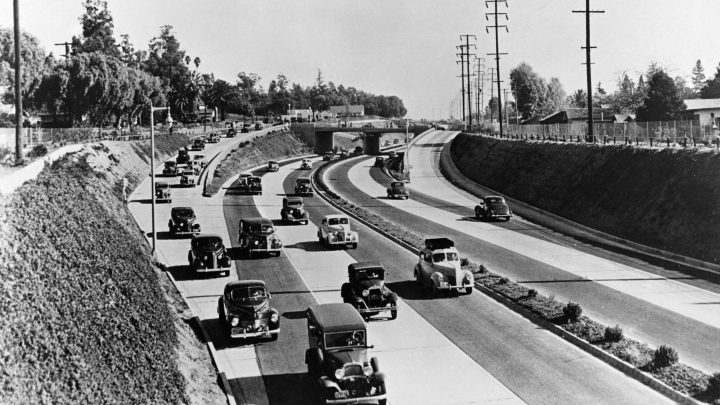
The New Deal history in LA’s freeways

The Arroyo Seco Parkway, formerly known as the Pasadena Freeway, is California’s first freeway and one of the oldest in the country. It was built with the help of federal New Deal agencies and funding, according to the Living New Deal, a research project and nonprofit based in California.
Construction of the initial, 6-mile stretch of the Arroyo Seco Parkway was completed in 1940, making it the first portion of today’s Los Angeles freeway system. It connects Pasadena to downtown Los Angeles, and at the time of its opening, it cut travel time between the two population centers from 27 to 12 minutes.

“Marketplace” host Kai Ryssdal visited Kenn Bicknell of the L.A. County Metropolitan Transportation Authority at his office to learn more about the freeway’s history. Bicknell is senior manager for policy research and library services at the transit agency.
“I’m sure most people in the Los Angeles area have driven on this first freeway,” Bicknell said. “I think it has a special place in people’s hearts here. It’s something that Angelenos should be proud of.”
LA Metro’s research library has archival documents going back to the 1890s, including books and other materials about the creation and opening of the Arroyo Seco Parkway.
“In the 1920s, the cities of Los Angeles and Pasadena both agreed that there should be a scenic parkway between the two population centers of the county,” Bicknell said. “And they decided to build this parkway, which a big part of it was so that it was a scenic, enjoyable thing. This was not for commuters necessarily.”
At the time, the Arroyo Seco Parkway was designed for cars to drive at a maximum speed of 45 miles per hour, according to Bicknell.
“The lanes, which are pretty narrow by today’s standards, still exist,” Bicknell said. “You enter and exit from a dead stop. There was supposed to be a great median with foliage, which disappeared because they needed to expand it fairly rapidly.”
The freeway was originally designed to carry approximately 27,000 cars per day. But according to more recent estimates, more than 122,000 cars hit the Arroyo Seco daily.
There’s a lot happening in the world. Through it all, Marketplace is here for you.
You rely on Marketplace to break down the world’s events and tell you how it affects you in a fact-based, approachable way. We rely on your financial support to keep making that possible.
Your donation today powers the independent journalism that you rely on. For just $5/month, you can help sustain Marketplace so we can keep reporting on the things that matter to you.












